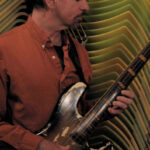“Guitar Toss” by Jack Vees
Title:
- Guitar Toss
Artist(s) and People Involved:
Exhibiting Artist(s):
Symposium:
Artist Statement:
I began writing installation pieces while a student at Cal Arts in the early 1980s. One of my teachers there was Louis Andriessen. We had many discussions about the limitations of standard “concert music”. One of my responses to this was to incorporate another category of pieces I called “Instrumentallations”.
At first, each of these pieces focused on a particular instrument, and ways to create what might now be called “pop-up” performances. The first of these was for oboe. Then I did one for flute, then for cello, and another for a grand piano in a large plastic bubble.
Initially these Instrumentallations were designed for a solo performer, and an audience that would encounter these pieces outside of the concert hall. At some point (and Guitar Toss might be the first of this variant), audience participation began to be incorporated into them.
This often also had subtle connections to activities like circus or carnival games, and again Guitar Toss is very reminiscent of that sort of atmosphere. There are a number of electric guitars hanging, sometimes from a simple wooden beam, other times it was more elaborate, with a metal sculpture being the support.
All of the guitars are plugged into amplification, and each of them are tuned in a specific way. Some are open chords, some clusters, some all high (or low) pitches. Some of the guitars are also running through typical effects pedals such as delay, fuzz, chorus, etc.
The audience/participants are separated from the guitar by a waist high railing (or counter top) that maintains a distance of about 5-6 meters. The audience is then given the opportunity to throw balls (usually tennis balls) at the guitars in an attempt to hit them and thus “play” them.
Sometimes the audience is happy enough to just test their skill and see if they can accurately throw a ball to hit them. Other times, they might try to organize which guitars they hit to create a series of sequenced sound events, and they become very focused on it.
Much like a carnival game, each person playing the installation is given a set number of balls (usually 3-5) At some performances the audience actually paid a donation for a set number of balls, and the proceeds were given to a charity.
Additional Images:
Category:
All Works by the Artist(s) in This Archive:
- Jack Vees
- More Art Events from Jack Vees in this archive:

Guitar Toss
[ FISEA'93]









